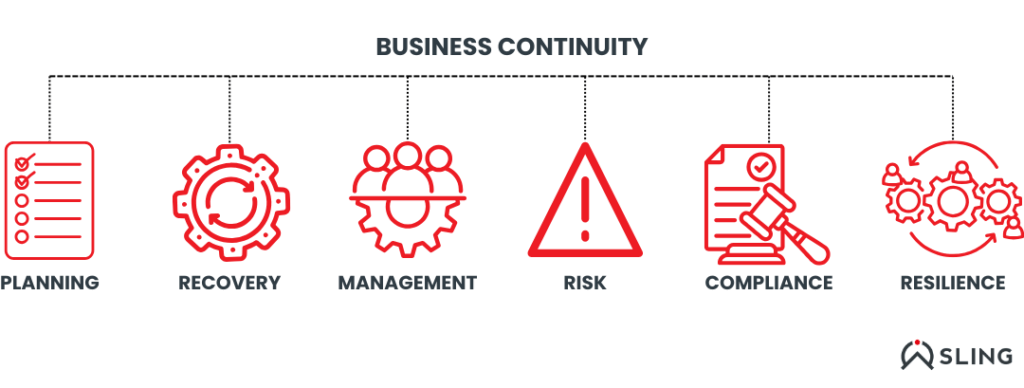Business continuity management has always been a critical part of running a successful business. Companies in every industry face risks that could disrupt their operations; whether it’s a natural disaster, a data breach, or an unexpected system failure. But as businesses increasingly rely on third-party vendors for essential services, the stakes have grown higher.
When a business relies on outside partners, it’s also opening the door to new risks. A cyberattack or failure at one of a company’s key vendors can affect everything from revenue to brand reputation, making it clear that business continuity isn’t just an internal concern; it extends to every link in the supply chain.
The challenge lies in the fact that organizations often lack visibility into third-party vendors’ risk management and recovery strategies. As a result, organizations must navigate these complexities carefully during contract negotiations, ensuring that they include provisions like the right to audit and establish clear communication protocols. Third-party risk management (TPRM) plays a vital role in helping organizations address these concerns and protect against potential disruptions.
This article will explore why TPRM is essential for business continuity, the risks posed by relying on third parties, and how businesses can put the right measures in place to protect their operations from unexpected disruptions.
The Growing Importance of Third-Party Risk Management
1. The Surge in Third-Party Dependency
Modern businesses are increasingly dependent on third-party vendors for essential services like IT infrastructure, customer support, and supply chain management. As industries become more digital and global, this reliance intensifies. While third-party relationships offer numerous benefits, they also introduce risks that can severely impact operations. A disruption in a key vendor’s service can cause cascading effects across a business, including delays, financial losses, and reputation damage.
2. Disruptions from Vendor Failures
The ripple effect of a vendor failure goes far beyond the vendor itself. A disrupted vendor can jeopardize the entire operation, affecting everything from customer satisfaction to financial stability. Even short-lived disruptions can lead to significant setbacks, and prolonged issues can result in customer churn, lost revenue, and long-term reputational harm. Therefore, businesses must plan for vendor-related risks and have measures in place to maintain continuity during such events.
3. Cybersecurity Risks in Vendor Relationships
Cybersecurity has become a pressing concern for businesses worldwide, and vendor relationships are often the weak link in the chain. With vendors handling sensitive data and customer information, a breach in their system can leave a business vulnerable to cyberattacks. To safeguard against these threats, companies must assess their vendors’ cybersecurity protocols, requiring them to adhere to industry best practices. Vendors should also have transparent recovery strategies to quickly mitigate the impact of any cyber incident.
4. Regulatory and Compliance Pressures
Businesses across industries face strict regulatory requirements related to data protection, risk management, and business continuity. These regulations extend to third-party vendors, meaning companies must ensure that their partners comply with the same standards. Failing to meet these compliance requirements can result in penalties and reputational damage. Therefore, effective third-party risk management is crucial for ensuring ongoing compliance and avoiding costly legal issues.

The Key Benefits of Third-Party Risk Management
Implementing a robust TPRM strategy offers several advantages beyond mitigating disruptions. These benefits extend to enhancing operational resilience, financial stability, and customer satisfaction.
1. Improved Operational Resilience
One of the primary benefits of TPRM is the ability to improve operational resilience. By identifying and managing risks early, businesses can respond swiftly to disruptions, whether they are caused by a vendor failure, a natural disaster, or a cyberattack. This proactive approach ensures that critical business functions continue without major interruptions, allowing businesses to weather any challenges that arise.
2. Minimizing Financial Losses
Third-party disruptions can lead to significant financial losses due to service outages, data breaches, or delayed deliveries. With a strong TPRM strategy, businesses can reduce the financial impact of such disruptions. By ensuring that vendors have recovery plans in place, companies can minimize downtime and prevent long-term financial consequences. Ongoing monitoring of vendor performance also helps businesses identify potential risks before they escalate.
3. Boosting Customer Confidence and Protecting Reputation
Business continuity is crucial not only for maintaining internal operations but also for protecting customer relationships. Customers expect reliable service, and any disruption due to a vendor failure can undermine their confidence. A well-implemented TPRM strategy shows customers that a company is committed to ensuring uninterrupted service, even during challenging times. This strengthens customer trust, enhances reputation, and increases the likelihood of retaining loyal clients.
4. Regulatory Compliance and Risk Mitigation
As industries face increasingly stringent regulations, businesses must ensure they are compliant with relevant laws, especially those that govern data security and continuity. Third-party risk management plays a pivotal role in ensuring that vendors adhere to these regulations, thus avoiding legal penalties. By assessing vendors for compliance with standards such as GDPR, HIPAA, and PCI DSS, businesses can reduce the risk of violations and strengthen their overall regulatory standing.
5. Strategic Decision-Making and Planning
Effective third-party risk management provides valuable insights into the stability, cybersecurity practices, and risk profiles of vendors. Armed with this information, businesses can make more informed decisions about which vendors to partner with and how to structure those relationships. This strategic approach allows businesses to diversify their vendor base, reduce reliance on a single partner, and prepare contingency plans for potential disruptions.
The reliance on third-party vendors comes with inherent risks that can quickly disrupt business operations. However, by investing in a comprehensive third-party risk management strategy, companies can safeguard their operations from unforeseen interruptions. From ensuring regulatory compliance to enhancing operational resilience, effective TPRM helps businesses maintain continuity and customer trust, even in the face of challenges. By continuously evaluating vendor risks and preparing for disruptions, companies can ensure they are always ready for the unexpected, keeping their operations running smoothly.



